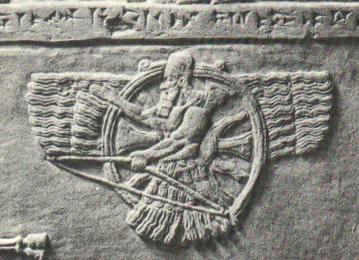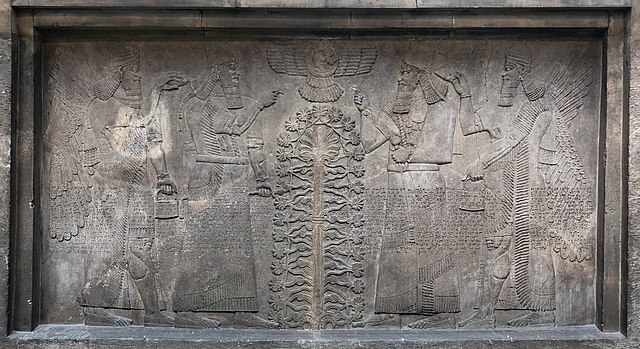
| ASHUR (GOD)
A Neo-Assyrian relief of Ashur as a feather robed archer holding a bow instead of a ring (9th-8th century BC)
Other names : Bêlu Rabû, Ab Ilâni,
Šadû Rabû
Ashur, Ashshur, also spelled Ašur, Aššur (Sumerian: AN.ŠAR2, Aš-šur, da-šur4) is an East Semitic god, and the head of the Assyrian pantheon in Mesopotamian religion, worshipped mainly in the northern half of Mesopotamia, and parts of north-east Syria and south-east Asia Minor which constituted old Assyria. He may have had a solar iconography.
Legend
:
During the various periods of Assyrian conquest, such as the Assyrian Empire of Shamshi-Adad I (1813–1750 BC), Middle Assyrian Empire (1391–1056 BC) and Neo-Assyrian Empire (911–605 BC), Assyrian imperial propaganda proclaimed the supremacy of Ashur and declared that the conquered peoples had been abandoned by their own gods.
When Assyria conquered Babylon in the Sargonid period (8th–7th centuries BC), Assyrian scribes began to write the name of Ashur AN.ŠAR2, the ideograms for "whole heaven" in Sumerian, which came to be pronounced Aššur in the Assyrian dialect of Akkadian, the language of Assyria and Babylonia. The intention seems to have been to put Aššur at the head of the Babylonian pantheon, where Anshar and his counterpart Kishar ("whole earth") preceded even Enlil and Ninlil. Thus in the Sargonid version of the Enuma Elish, the Babylonian national creation myth, Marduk, the chief god of Babylon, does not appear, and instead it is Ashur, as Anshar, who slays Tiamat the chaos-monster and creates the world of humankind.
Representation and symbolism :
Wall relief depicting the God Ashur (Assur) from Nimrud
Ashur is depicted on this variant of the flag used by the modern Assyrian people Some scholars have claimed that Ashur was represented as the winged sun that appears frequently in Assyrian iconography. [who?] Many Assyrian kings had names that included the name Ashur, including, above all, Ashur-uballit I, Ashurnasirpal, Esarhaddon (Ashur-aha-iddina), and Ashurbanipal. Epithets include bêlu rabû "great lord", ab ilâni "father of gods", šadû rabû "great mountain", and il aššurî "god of Ashur". The symbols of Ashur include :
An Assyrian standard, which probably represented the world column, has the disc mounted on a bull's head with horns. The upper part of the disc is occupied by a warrior, whose head, part of his bow, and the point of his arrow protrude from the circle. The rippling water rays are V-shaped, and two bulls, treading river-like rays, occupy the divisions thus formed. There are also two heads—a lion's and a man's—with gaping mouths, which may symbolize tempests, the destroying power of the sun, or the sources of the Tigris and Euphrates. Jastrow regards the winged disc as "the purer and more genuine symbol of Ashur as a solar deity". He calls it "a sun disc with protruding rays", and says: "To this symbol the warrior with the bow and arrow was added—a despiritualization that reflects the martial spirit of the Assyrian empire".
The
Assyrian Tree of Life :
King Ashurnasirpal's throneroom relief showing Ashur hovering above the tree of life Parpola continues by drawing on parallels between the Ein Sof in the Kabbalah and the symbolism of Ashur with the Tree of life. The depiction of Ashur, the universal God, behind a solar disk, representing light as his essential nature, just as in Kabbalah, is just one instance of Parpola's comparison.
Source :
https://en.wikipedia.org/ |

_from_Nimrud..jpg)
.svg.png)
